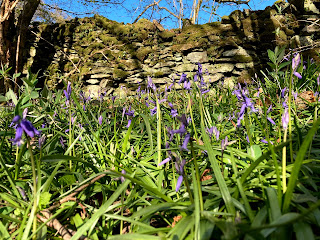Planting for Biodiversity
Another visit and so much to take in. Martin Wain, Conservation Officer, came to help me consider options for when I am planting my wood that would encourage invertebrates. He introduced me to flowers and trees I had not identified (or indeed spotted) before. So much to take in and here are my take aways. He has offered to come again when I am nearer putting a detailed plan together and when I have seen more seasons unfold.
Current diversity
From the land being grazed over the years, it lacks diversity of plants and flowers. The difference from the roadside to inside is quite stark and shows that the land needs to recover from being grazed and to be stimulated by adding plants from neighbours in the Gilpin Valley.
Planting for biodiversity
To encourage wildlife and invertebrates in particular a variety of planting is best ie not densely packed rows of trees. Martin recommended planting groups of trees densely then having space between these groups to create areas protected from the wind and ideally sun traps to encourage flowers and insects. Scallop shapes. These warm up which is needed for invertebrates who are cold blooded. There are some natural ones already which helpfully had bumblebees feeding on cowslips as we walked round demonstrated their benefit. These and primroses also attract Duke of Burgundy butterflies although none have been spotted locally.
Martin identified areas which show high nitrates in the ground - with nettles and raspberries. These areas may have had feeders for livestock and do not have wild flowers.
Bracken and violets together are an excellent combination for a specific butterfly - the High brown Fritillary which has been spotted 1km away. It would be sensible to record where these are growing together now as the violets will finish soon and the new bracken is growing and I won't remember where these precious combinations exist and I can choose not to disturb some of these areas.
Yew trees are bullies apparently and crowd out deciduous trees and so need to be kept under control (this was a shock to me but evidence of a deciduous tree failing next to a yew demonstrated the problem - I'll take a photo to add here next time I go up)
There are elms thriving in South Cumbria and can be introduced onto the site which would be fabulous to include in the new wood. I haven't knowingly seen an elm since I was a child growing up in Surrey and I remember the devastation of Dutch Elm Disease so this would feel like a really positive step for the long term.
Margins - since the neighbouring land is heavily grazed the margins can be developed. The idea is to keep the hawthorn/ elder/ hazel trees already present along the fences - maybe thin these, then leave space for scrub to grow before planting mid height trees such as hazel and then the taller trees behind. This will give a wide range of invertebrates the best chance of accessing the habitat they require. This would work best if the deer fence does not run along the current fence but inside by a couple of metres and therefore the deer will keep some of the scrub in shape and the edges can continue to thrive as they are.
Fence posts can connect with pollarded trees and do not need to be straight but use natural features.
Coppicing hazel trees would be the traditional approach and if someone is interested in coppicing they would pay to be access the land to undertake this work.
Trees spotted
Rowans - they are everywhere! I had spotted 3 after the South Lake Woodlanders visited last week and now I think its at least 10. I'll see if I can learn to identify them in winter next year.
Mysterious
The early purple orchids have disappeared without a trace - a mystery I am unlikely to solve! I shall keep looking out for more.
I am sure I am looking in the right place but there aren't even any leaves remaining. I shall keep looking! But how to feel a fool - promise these beauties and find just last year's bracken!
Finally....
most of my photos of badgers show them going about their business. I would love to see them just hanging around, grooming themselves or interacting.
Martin let me know the secret - Sugar Puffs hidden in the grass which they have to dig around to find. They love them apparently!



















Comments
Post a Comment